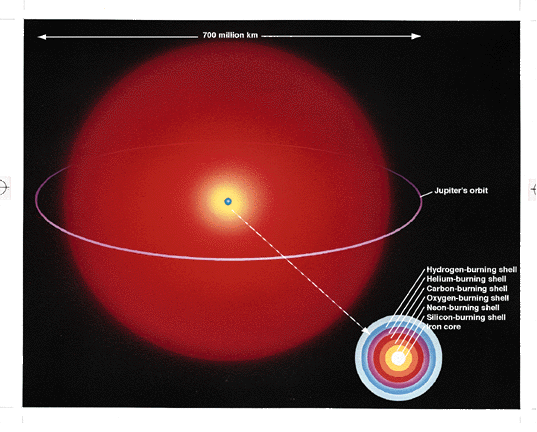VV Cephei A: The Truly Big Star

{ Audio this essay @ 1MB @ 2.5mins. } Recently, I learned about VV Cephei A, which is classified as a "supergiant". It is one of the largest stars known. It leaves me wondering just how big a star can get. From Wikipedia:
[VV Cephei A] is of spectral type M2 and is about 1600-1900 times the Sun's diameter. If it replaced the Sun in our solar system, it would extend to the orbit of Saturn. It is 275,000-575,000 times as luminous as the Sun. The mass of the star is unknown. The mass estimated from its orbital motion is about 100 solar masses. On the other hand, the mass estimated from its luminosity is about 25-40 solar masses.[1]
There is an excellent video[2] I recently ran across which shows the size relationship of planetary and star objects in a sweeping pass.
Of course, there are life cycles to stars, so this baby will eventually build up too much iron to maintain its even-keel status:
As massive red supergiants age, they produce "onion layers" of heavier and heavier elements in their interiors. However, stars will not fuse elements heavier than iron. Fusing iron doesn't release energy. It uses up energy. Thus a core of iron builds up in the centers of massive supergiants.[3]
As it builds up too much, the density forces neutrons and neutrinos to interact (which they normally don't do easily), which causes the iron core to crash-in on itself causing a giant rebound effect:
These two effects -- neutrino outburst and rebound shock wave -- cause the entire star outside the core to be blow apart in a huge explosion: a type II supernova! supernovae are really bright -- about 10 billion times as luminous as the Sun. Supernovae rival entire galaxies in brightness for weeks. They tend to fade over months or years. During the supernova, a tremendous amount of energy is released. Some of that energy is used to fuse elements even heavier than iron! This is where such heavy elements like gold and silver and zinc and uranium come from![4]
I still find it eerie that the very gold in my wedding ring was forged millions of years ago by some VV Cephei A -like star blowing itself to bits.[5]
REFERENCES
[1] "VV Cephei" Wikipenda (Accessed 1/5/06)
[2] "...some stars and planets in scale" Google Video (Accessed 1/5/06)
[3] "The Stellar Lifecycle: Massive Red Supergiant" UC Berkeley's Space Sciences Laboratory: The Universe of Brtyan Mendez(Accessed 1/5/06)
[4] "Type II Supernova" UC Berkeley's Space Sciences Laboratory: The Universe of Brtyan Mendez(Accessed 1/5/06)
[5] "Supernova Explosion" Google Video (Accessed 1/5/06)
.O.
Labels: Astronomy, Star, Supergiants, Supernova, VV Cephei A



0 Comments:
Post a Comment
<< Home